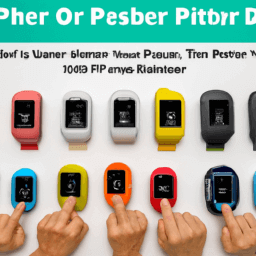What are the Pulse Oximeter types. Which one is best?
There are two main types of pulse oximeters: fingertip and handheld. Fingertip pulse oximeters are small, portable, and easy to use. Handheld pulse oximeters are larger and typically used in clinical settings. Both types measure oxygen saturation levels in the blood and pulse rate. The best type depends on the intended use and personal preference. Fingertip pulse oximeters are more convenient for personal use, while handheld pulse oximeters are more accurate and reliable for clinical use.
What are the Pulse Oximeter types. Which one is best?
Pulse oximeters are devices that measure the oxygen saturation level in the blood. They are commonly used in hospitals, clinics and homes to monitor the oxygen levels of patients with respiratory conditions such as asthma, COPD, pneumonia, and COVID-19. There are different types of pulse oximeters available in the market, each with its own features and benefits. In this article, we will discuss the different types of pulse oximeters and which one is best for you.
Finger Pulse Oximeter
The finger pulse oximeter is the most common type of pulse oximeter. It is a small device that is attached to the fingertip and measures the oxygen saturation level in the blood. The finger pulse oximeter is portable, easy to use, and provides accurate readings within seconds. It is ideal for home use and for monitoring oxygen levels during exercise or high altitude activities.
The finger pulse oximeter is suitable for adults and children, and it is available in different sizes to fit different finger sizes. It is also affordable and widely available in medical stores and online. The finger pulse oximeter is powered by batteries and can be used for several months before the batteries need to be replaced.
Wrist Pulse Oximeter
The wrist pulse oximeter is a wearable device that is worn on the wrist like a watch. It measures the oxygen saturation level in the blood and displays the readings on a screen. The wrist pulse oximeter is ideal for people who need to monitor their oxygen levels continuously, such as those with sleep apnea or chronic obstructive pulmonary disease (COPD).
The wrist pulse oximeter is more expensive than the finger pulse oximeter, but it provides more features and benefits. It is more comfortable to wear, and it can store data for several days or weeks. Some wrist pulse oximeters also come with alarms and alerts to notify the user when their oxygen levels are low.
Handheld Pulse Oximeter
The handheld pulse oximeter is a portable device that is used by healthcare professionals to measure the oxygen saturation level in the blood. It is larger than the finger pulse oximeter and comes with a probe that is attached to the patient's finger, earlobe, or toe. The handheld pulse oximeter provides accurate readings and is ideal for use in hospitals, clinics, and emergency situations.
The handheld pulse oximeter is more expensive than the finger pulse oximeter and requires some training to use. It is also bulkier and less portable than the finger pulse oximeter. However, it provides more advanced features and can be used to monitor patients with different medical conditions.
Pediatric Pulse Oximeter
The pediatric pulse oximeter is a specialized device that is designed for children. It is similar to the finger pulse oximeter but comes with smaller probes and sensors that are suitable for children's fingers. The pediatric pulse oximeter is ideal for monitoring the oxygen levels of infants and young children who have respiratory conditions.
The pediatric pulse oximeter is more expensive than the finger pulse oximeter, but it provides more accurate readings for children. It is also more durable and can withstand rough handling by children. Some pediatric pulse oximeters also come with alarms and alerts to notify parents or caregivers when their child's oxygen levels are low.
Conclusion
In conclusion, there are different types of pulse oximeters available in the market, each with its own features and benefits. The finger pulse oximeter is the most common type and is ideal for home use and for monitoring oxygen levels during exercise or high altitude activities. The wrist pulse oximeter is ideal for people who need to monitor their oxygen levels continuously, such as those with sleep apnea or COPD. The handheld pulse oximeter is ideal for use in hospitals, clinics, and emergency situations. The pediatric pulse oximeter is ideal for monitoring the oxygen levels of infants and young children who have respiratory conditions.
| Type of Pulse Oximeter | Features | Benefits | Price |
|---|---|---|---|
| Finger Pulse Oximeter | Portable, easy to use, accurate readings, suitable for adults and children | Ideal for home use and for monitoring oxygen levels during exercise or high altitude activities | Affordable |
| Wrist Pulse Oximeter | Wearable, continuous monitoring, stores data, alarms and alerts | Ideal for people with sleep apnea or COPD | Expensive |
| Handheld Pulse Oximeter | Accurate readings, advanced features, suitable for different medical conditions | Ideal for use in hospitals, clinics, and emergency situations | Expensive |
| Pediatric Pulse Oximeter | Specialized for children, accurate readings, durable, alarms and alerts | Ideal for monitoring infants and young children with respiratory conditions | Expensive |
| By www.zelect.in | |||
Sharing is caring!
Facebook Twitter Email
Recommended articles for Pulse Oximeter
Pulse Oximeter types and buying guide
-
Pulse oximeter buying guide. How to choose the right oximeter
-
What is a Pulse Oximeter
-
What are the Pulse Oximeter types. Which one is best?
-
What is the normal oxygen saturation on Pulse Oximeter
-
Which brand is best for Pulse Oximeter India
-
Does a Pulse Oximeter measure blood pressure
-
Does a Pulse Oximeter measure heart rate
-
Does Apple watch have Pulse Oximeter
-
How accurate is a Pulse Oximeter
-
What are the 2 readings on a Pulse Oximeter
-
Which finger to use for Pulse Oximeter
-
What does a Pulse Oximeter measure
-
What is a normal oxygen saturation reading on Pulse Oximeter
-
Can Pulse Oximeter detect sleep apnea


